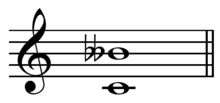Diminished seventh
| Inverse | augmented second |
|---|---|
| Name | |
| Other names | - |
| Abbreviation | d7[1] |
| Size | |
| Semitones | 9 |
| Interval class | 3 |
| Just interval | 128:75[2] or 216:125[3] |
| Cents | |
| Equal temperament | 900 |
| Just intonation | 925 or 947 |

In classical music from Western culture, a diminished seventh (![]() play ) is an interval produced by narrowing a minor seventh by a chromatic semitone.[1][4] For instance, the interval from A to G is a minor seventh, ten semitones wide, and both the intervals from A♯ to G, and from A to G♭ are diminished sevenths, spanning nine semitones. Being diminished, it is considered a dissonant interval.[5]
play ) is an interval produced by narrowing a minor seventh by a chromatic semitone.[1][4] For instance, the interval from A to G is a minor seventh, ten semitones wide, and both the intervals from A♯ to G, and from A to G♭ are diminished sevenths, spanning nine semitones. Being diminished, it is considered a dissonant interval.[5]
The diminished seventh is enharmonically equivalent to a major sixth. Its inversion is the augmented second.
The diminished seventh is used quite readily in the minor key, where it is present in the harmonic minor scale between the seventh scale step and the sixth scale step in the octave above.
In an equal tempered tuning, a diminished seventh is equal to nine semitones, a ratio of 29/12:1 (approximately 1.682), or 900 cents. There is no standard just tuning of this interval, but one possibility, assuming the flat submediant is a perfect (5:4) major third below the octave, and the leading tone to be 15:16, would lead to an interval of 128:75, about 925 cents; another interval is 216:125, which is three minor thirds.
The 128:75 just diminished seventh arises in the C harmonic minor scale between B and A♭ by combining B-D, D|F, F-A♭.[6] ![]() Play
Play
See also
Sources
- ↑ 1.0 1.1 Benward & Saker (2003). Music: In Theory and Practice, Vol. I, p.54. ISBN 978-0-07-294262-0. Specific example of an d7 not given but general example of minor intervals described.
- ↑ Haluska, Jan (2003). The Mathematical Theory of Tone Systems, p.xxvi. ISBN 0-8247-4714-3. Diminished seventh.
- ↑ Haluska (2003), p.xxvi. Acute diminished seventh.
- ↑ Hoffmann, F.A. (1881). Music: Its Theory & Practice, p.89-90. Thurgate & Sons. Digitized Aug 16, 2007.
- ↑ Benward & Saker (2003), p.92.
- ↑ Paul, Oscar (1885). A manual of harmony for use in music-schools and seminaries and for self-instruction, p.165. Theodore Baker, trans. G. Schirmer.
| ||||||||||||||||||||||||||||||||||||||||||||||||||||||||||||